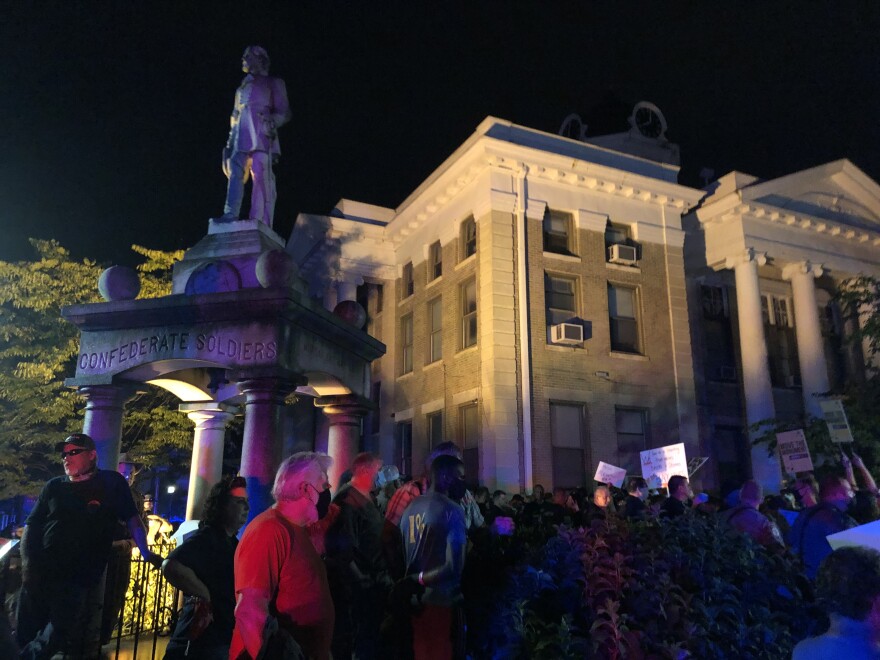A planned march and protest Friday evening calling for the removal of a Confederate monument on Calloway County courthouse grounds drew hundreds of people combined for and against the removal, in what marked the seventh straight week of protests at the monument.
Monument removal advocates — who planned the protest on the 57th anniversary of the March on Washington— marched from Murray State University through the city of Murray to the Confederate monument on the downtown court square, where they were met with dozens of counter-protesters.
Law enforcement stood between the opposing sides near the monument as tensions rose at times. Removal advocates chanted phrases including, “This racist statue’s got to go,” and, “Black Lives Matter,” some waving signs calling for the removal of the monument. Counter-protesters stood by and on the Confederate monument, which features a statue of Confederate general Robert E. Lee. The protests remained peaceful throughout the night with most, but not all, protesters wearing masks.
The crowd grew to at least 200 people combined as monument removal advocates spoke to the growing crowd and read speeches from the corner of the courthouse. Murray State University Football Coach Sherman Neal, who first sparked calls to remove the monument, read a speech by civil rights leader John Lewis in marking the civil rights anniversary. A Murray State senior from Birmingham, Alabama, also spoke to the crowd, talking emotionally at times about his upbringing and about how he sees the monument as creating division.
“The civil rights movement was real prevalent in Birmingham, Alabama, and I’ve been going to different museums and stuff like that growing up, and I felt like it would be different here. And when I found out that it wasn’t, a lot of people believe lies that you’re supposed to be silent on things like this that it will just go away,” said Ernest Kenty, 22, after his speech. “And when you put up a monument like this, it’s basically worshipping the values that they believed in the past, and it’s not right.”
The crowd listening to speeches by removal advocates appeared to be somewhat larger than the group of counter-protesters by the monument. Protests at the monument have persisted for seven straight weeks since the Calloway County Fiscal Court unanimously passed a resolution stating the monument would stay, but for some it was their first demonstration at the monument, including 23-year-old Jaishon Faison.
“I’ve been conditioned to accept the confederacy around here,” said Faison, a Black man from Cadiz. “I feel like the narrative in our nation is that young people don’t care about anything. It’s not about themselves and the immediate present. And this shows young people care about politics. We care.”
He said he believes the persistence of the protests will help keep conversation about the monument ongoing. Faison also said if the monument garners national attention in the future, “you never know what could happen.”

As with several protests in past weeks at the monument, protesters supportive of the monument’s location next to the courthouse stayed close to the statue, many worried it could be torn down. Leading removal advocates have stated in the past they support the relocation of the monument to other places including a nearby cemetery, and not the destruction of it. But Adam Maupin of Murray worries it could be defaced if it’s not on the courthouse square and within a block from the Murray Police Department.
“If it was to be dedicated to a museum or something beneficial to where it could still be not enjoyed, but acknowledged, that wouldn’t be a half-bad idea,” said 21-year-old Adam Maupin of Murray. “But the problem is with this ‘cancel culture’ of wanting to tear down these monuments, you’re not going to have that, because the first time there’s not an armed guard, someone’s going to deface it.”
When asked about how many Black community members consider the monument to be a symbol of oppression and a reminder of their ancestors’ enslavement, Maupin said that people have to be more tough.
“Every now and again, people have to get their toes stepped on. It’s what makes Americans tough. That’s why we’ve won almost every war we’ve ever been in, because we’re resilient,” he said.
The crowd thinned as the protest wore on into the evening, with the protesters talking amongst themselves and music playing in the background.





